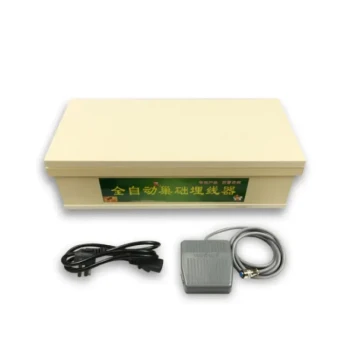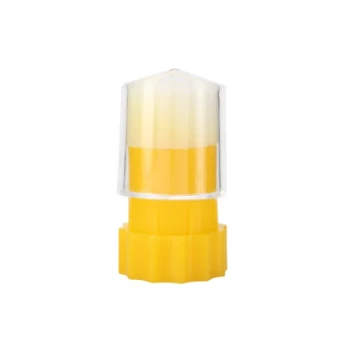In beekeeping, your boots serve as the foundation of your protective gear. Their primary role is to shield your feet and ankles from stings and, most critically, to create a secure seal at the bottom of your bee suit. This prevents curious bees from crawling up your legs, ensuring you remain safe and calm while working with your hives.
The most common point of failure in a beekeeper's suit is an unsecured opening. While stings to the feet are less common, a gap between your boots and pants is an open invitation for bees, turning a routine inspection into a stressful event.

The Core Functions of Beekeeping Boots
Proper footwear goes beyond simply covering your feet. It serves three distinct purposes that are essential for a safe and productive beekeeping experience.
Sealing the Suit at Ground Level
Bees that are disturbed or dislodged from a frame often fall to the ground. Their natural instinct is to crawl upwards toward darkness, making any gap in your suit a primary target.
The most critical function of your boots is to allow the elastic cuffs of your suit pants to fit securely over them. This creates a physical barrier that bees cannot bypass.
Protection Against Stings
While bees tend to target the head and hands, the feet are not immune. The risk increases significantly if you accidentally drop a frame of bees or step too close to a defensive colony's entrance.
A sturdy boot made of rubber, leather, or another non-porous material will prevent a bee's stinger from penetrating through to your skin.
Providing Stability and Comfort
Apiaries are often located on uneven or soft ground. Beekeeping also involves standing for long periods and lifting heavy boxes (supers) filled with honey.
Good boots provide the ankle support and underfoot comfort needed to work safely and without fatigue. This stability helps prevent trips and falls, which can be dangerous when you are surrounded by thousands of bees.
Understanding the Trade-offs and Common Mistakes
Choosing the right footwear involves balancing protection with practicality. Avoiding common errors is key to staying safe.
The Critical Mistake of Inadequate Footwear
Never wear sandals, athletic sneakers, or any low-cut shoe into an apiary. Porous materials like mesh offer no protection from stings, and a low cut makes it impossible to create a secure seal with your pant legs.
The "Tucking In" Myth
A frequent mistake made by beginners is tucking their pant legs into their boots. This creates a funnel that can guide bees directly onto your skin. Always ensure your pant cuffs are pulled down firmly over the outside of your boots.
Overlooking Comfort
While a heavy-duty rubber boot offers maximum protection, it can be hot and cumbersome during long days in the sun. Consider the climate and the length of time you'll be working. An uncomfortable beekeeper is a distracted one.
Making the Right Choice for Your Goal
Select your footwear based on your specific priorities for protection, comfort, and apiary conditions.
- If your primary focus is maximum protection and ease of cleaning: Choose tall, waterproof rubber or neoprene boots (often called "muck boots").
- If your primary focus is all-day comfort and versatility: A sturdy pair of leather work boots that fully covers the ankle is an excellent choice.
- If you are working on a tight budget: Any simple rubber rain boot that is tall enough to cover your ankles will provide effective protection.
Ultimately, the best boot is one that allows you to create an unbroken seal with your suit and work confidently in your apiary.
Summary Table:
| Function | Key Benefit |
|---|---|
| Suit Seal | Prevents bees from crawling up legs |
| Sting Protection | Shields feet and ankles from stings |
| Stability & Comfort | Provides support for lifting and standing |
Equip your apiary with confidence. HONESTBEE supplies durable, protective beekeeping boots and full suits designed for the demands of commercial apiaries and distributors. Ensure your team's safety and productivity with our wholesale-focused equipment. Contact HONESTBEE today to discuss your bulk supply needs.
Visual Guide

Related Products
- Cotton Beekeeping Suit and Round Hat with Veil Bee Keeper Protective Gear
- Professional Beekeeping Suit for Kids and Girls Childrens Bee Keeper Suit
- Beekeeper Cowboy Hat and Veil for Beekeeping
- High Performance Plastic Queen Excluder for Beekeeping and Apiary Management
- Premium Traditional Copper Bee Smoker with Bellows
People Also Ask
- What is recommended for beginners in beekeeping regarding protective clothing? A Complete Safety Guide for New Beekeepers
- Why is a jacket with a hat veil recommended for beekeepers? Essential Protection for Your Face and Neck
- What are the benefits of a fully ventilated beekeeping suit? Stay Cool and Protected in Hot Climates
- How should a beekeeping suit be hung to maintain its shape? Protect Your Investment with Proper Storage
- What should be considered regarding the color of beekeeping clothing? Ensure Your Safety and Keep Bees Calm



















